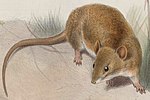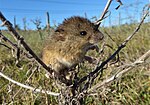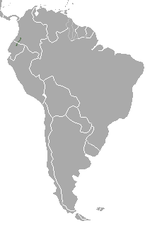 | palate is not produced behind to cover the anterior half of the mesopterygoid fossa, and is flat and expanded between the posterior cheek teeth. The... 7 KB (710 words) - 13:07, 8 March 2024 |
 | molars) are complex; the sphenopalatine vacuities (openings in the mesopterygoid fossa, the gap behind the end of the palate) are large; the pattern of... 16 KB (2,185 words) - 22:48, 5 October 2023 |
 | shape of the sphenopalatine vacuities (openings in the roof of the mesopterygoid fossa, the gap behind the palate), which are narrower and shorter than... 19 KB (1,932 words) - 02:18, 18 October 2023 |
 | and lack of sphenopalatine vacuities (openings in the roof of the mesopterygoid fossa, the gap behind the end of the bony palate). They considered that... 75 KB (9,224 words) - 03:55, 18 April 2024 |
rodents, sphenopalatine vacuities are perforations of the roof of the mesopterygoid fossa, the open space behind the palate, in between the parapterygoid fossae... 3 KB (318 words) - 02:18, 19 January 2023 |
 | back to a point close to the upper third molar. The sides of the mesopterygoid fossa (the opening behind the back margin of the palate) are more strongly... 9 KB (1,095 words) - 10:33, 5 March 2021 |
 | palatal pits at the back of the palate, near the third molars. The mesopterygoid fossa, an opening located behind the end of the palate, is broad and its... 14 KB (1,797 words) - 12:31, 7 July 2023 |
 | longer fur, and larger sphenopalatine vacuities (openings in the mesopterygoid fossa, the gap behind the end of the palate). As Weksler's 2006 analysis... 50 KB (5,891 words) - 11:37, 21 January 2024 |
 | featureless bony palate, without many pits and ridges, and a broad mesopterygoid fossa (the opening behind the palate). In other characteristics, Voalavo... 19 KB (2,160 words) - 21:24, 3 April 2022 |
 | (the portion of the palate between the incisive foramina and the mesopterygoid fossa behind the back end of the palate) is 4.29 mm long and 2.75 mm broad... 14 KB (1,844 words) - 13:22, 6 April 2024 |
 | the hard palate) that usually reach the first molar, and the short mesopterygoid fossa (a depression behind the end of the palate) which does not extend... 4 KB (490 words) - 18:40, 3 June 2023 |
displaced to the back from their usual position just before the mesopterygoid fossa into the fossa. The condition of the pits has been used to separate species... 11 KB (1,321 words) - 07:08, 11 March 2024 |













